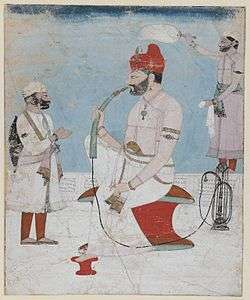Sansar Chand

Sansar Chand (c.1765–1823) was a famous ruler of the state of Kangra in what is now the Indian state of Himachal Pradesh. He is remembered as a patron of the arts, and the Kangra paintings.
Ascendency
Sansar Chand was a scion of the Katoch dynasty which had ruled Kangra for some centuries until they were ousted by the Mughals in the early 17th century. In 1758, Sansar Chand's grandfather, Ghamand Chand, had been appointed then governor of Jalandhar by Ahmed Shah Abdali. Building upon this background, Sansar Chand rallied an army, ousted the then ruler of Kangra, Saif Ali Khan, and regained possession of his patrimony. This happened in 1783, and Sansar Chand was aided by the Kanhaiya misl, one of several informal but well-armed Sikh militias that roamed the Punjab in that era. Sansar Chand has done a lot of work for the welfare of people mainly residing in places like Palampur, Hamirpur, Kangra. Many water distributaries were made in the name of king himself, this water was used to feed animals and for cultivation.
Decline
During the campaign, Sansar Chand and his mercenary force overran other nearby principalities and compelled the submission of their rulers. He reigned over a relatively large part of present-day Himachal Pradesh for some two decades, but his ambitions brought him into conflict with the Gurkhas ruling the then nascent state of Nepal. The Gorkhas and the recently humbled hill-states allied to invade Kangra in 1806. Sansar Chand was defeated and left with no territory beyond the immediate vicinity of the fortress of Kangra. They managed to defeat Sansar Chand Katoch, the ruler of Kangra, in 1806 with the help of many provincial chiefs. However, Gorkhas could not capture Kangra fort which came under Maharaja Ranjeet Singh in 1809.
Later years
Sansar Chand retired to the estates thus conferred upon him by Ranjit Singh and devoted his remaining years to cultural pursuits. He died in 1823, and was succeeded in his estates and titles by his son Anirudh Chand. The estate, which came under British suzerainty in 1846, was held by the progeny of Anirudh Chand until 1947, when it acceded unto the Dominion of India.
Apart from Anirudh Chand, Sansar Chand had two daughters by his wife, Prasanna Devi. Both of them were wed to the Raja Sudarshan Shah of Tehri Garhwal. Sansar Chand also had issue by his second wife,a commoner rajput lady Gulab Dasi; two daughters borne by her were wed, in 1829, to Ranjit Singh and also a son Raja Jodhbir Chand who established princely state of Nadaun .This is where Maharaja Sansar Chand spent his last days.
A museum to honour Maharaja Sansar Chand has been set up the members of the Katoch Dynasty. The museum is located near the Kangra Fort and houses the private collection of the Royal Family of Kangra.